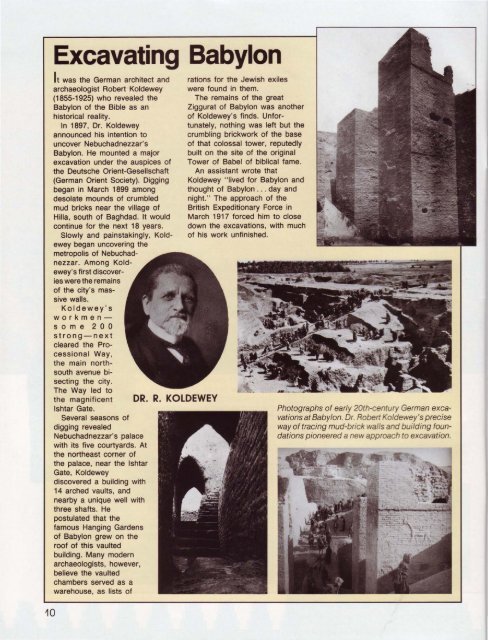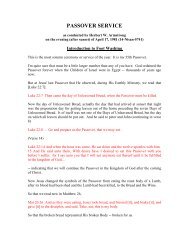Babylon - Past, Present and Future - Church of God - NEO
Babylon - Past, Present and Future - Church of God - NEO
Babylon - Past, Present and Future - Church of God - NEO
- No tags were found...
Create successful ePaper yourself
Turn your PDF publications into a flip-book with our unique Google optimized e-Paper software.
Excavating <strong>Babylon</strong>It was the German architect <strong>and</strong>archaeologist Robert Koldewey(1855-1925) who revealed the<strong>Babylon</strong> <strong>of</strong> the Bible as anhistorical reality.In 1897, Dr. Koldeweyannounced his intention touncover Nebuchadnezzar' s<strong>Babylon</strong>. He mounted a majorexcavation under the auspices <strong>of</strong>the Deutsche Orient-Gesellschaft(German Orient Society). Diggingbegan in March 1899 amongdesolate mounds <strong>of</strong> crumbledmud bricks near the village <strong>of</strong>Hilla, south <strong>of</strong> Baghdad. It wouldcontinue for the next 18 years.Slowly <strong>and</strong> painstakingly, Koldeweybegan uncovering themetropolis <strong>of</strong> Nebuchadnezzar.Among Koldewey'sfirst discoverieswere the remains<strong>of</strong> the city's massivewalls.Koldewey'sworkmensome200strong - nextcleared the ProcessionalWay ,the main northsouthavenue bisectingthe city.The Way led tothe magnificentIshtar Gate.Several seasons <strong>of</strong>digging revealedNebuchadnezzar's palacewith its five courtyards. Atthe northeast corner <strong>of</strong>the palace, near the IshtarGate, Koldeweydiscovered a building with14 arched vaults, <strong>and</strong>nearby a unique well withthree shafts. Hepostulated that thefamous Hanging Gardens<strong>of</strong> <strong>Babylon</strong> grew on thero<strong>of</strong> <strong>of</strong> this vaultedbuilding. Many modernarchaeologists, however,believe the vaultedchambers served as awarehouse, as lists <strong>of</strong>10DR. R. KOLDEWEYrations for the Jewish exileswere found in them.The remains <strong>of</strong> the greatZiggurat <strong>of</strong> <strong>Babylon</strong> was another<strong>of</strong> Koldewey's finds. Unfortunately,nothing was left but thecrumbling brickwork <strong>of</strong> the base<strong>of</strong> that colossal tower, reputedlybuilt on the site <strong>of</strong> the originalTower <strong>of</strong> Babel <strong>of</strong> biblical fame.An assistant wrote thatKoldewey " lived for <strong>Babylon</strong> <strong>and</strong>thought <strong>of</strong> <strong>Babylon</strong> . . . day <strong>and</strong>night." The approach <strong>of</strong> theBritish Expeditionary Force inMarch 1917 forced him to closedown the excavations, with much<strong>of</strong> his work unfinished.Photographs <strong>of</strong> early 20th-century German excavationsat Baby/on. Dr. Robert Ko/dewey's preciseway <strong>of</strong> tracing mud-brick walls <strong>and</strong> building foundationspioneered a new approach to excavation.
















